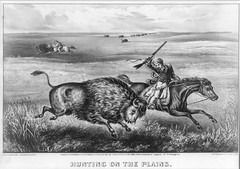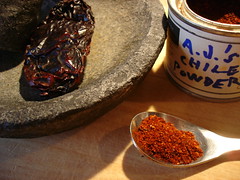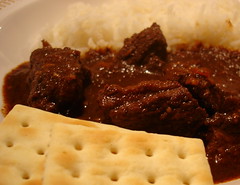Texas Red, rev. ed.
There was a time there, in my late teens and early twenties, when I prided myself on my chili--to the point that I hosted an annual chili fest on my birthday for a few years running. Cold beer, chili, corn bread, chips and salsa--that kind of thing. We'd always been big fans of chili in our family, but our chili had been very California, very much inspired by 1970s and '80s issues of Sunset. Then, in my late teens I discovered Texas-style chili (emphasis on the "-style") in the DC area, of all places. There was a small local chain there that prided itself on its authentic chilis and its resurrection of that old-time, Depression-era chili joint ambiance--The Hard Times Café--but it was also around then that we started to see "real Texas chili" spice blends and other chili-making paraphernalia--like the D.L. Jardine's line--on our supermarket's shelves. While I never turned my back entirely on the bean- and vegetable-heavy heresy I'd grown up with, Texas chili, with its complex spices, its heat, its use of beer and then-exotic ingredients like masa harina, and its cult of USDA beef, was a revelation. I was still very much a piker--I was relying on Chili For Dummies-type kits that came with packets of pre-ground spices and masa harina, for Christ's sake--but I'd gotten the bug and my chili was at least vaguely in tune with the dish's origins in the American Southwest.
Then came the period in my chili-making history known as "the interregnum," a period when my vegetarianism turned me 180º from the world of Texas chili, where vegetables are kept to an absolute minimum and bean are largely scoffed at. I made a pretty good vegetarian chili (again, much better than average) during those years, but this version of my chili had almost absolutely nothing to do with the American chili tradition--the one rooted in Texas, at least.
I've gone back to making Texas-style chili over the last few years. While I'm still something of a piker and I'm definitely not ready for Terlingua, TX and its thriving competition chili scene, I've got a much richer understanding of Texas chili and its roots, its meaning.  fig. a: the buffalo hunt
fig. a: the buffalo hunt
This is thanks in large part to John Thorne's masterful "Just Another Bowl of Texas Red" from Serious Pig, where he traces the dish's history back to the utterly orgiastic buffalo roasts (a festival of "meat, grease, and fire," to use Thorne's terms) that were such an important part of America's mythic frontier past, before launching into a thoughtful study of chili's bastard past, its strange absence from early literature on Texas regional cuisine (S. Compton Smith's 1857 Chile con Carne, or The Camp and the Field is the earliest trace cited by Alan Davidson, but this title is the exception to the rule--until the 1880s, that is), its rejection by both Texans and Mexicans, its secret origins, its official emergence in 1880s San Antonio, where it was served forth in Military Plaza by dozens of "chili queens," and its eventual triumph in the form of the chili joint, when it finally became a part of the mainstream of, first, Texan and, then, American culture. One thing's for sure, though, these days I mix my own chili spice blends and I don't have to rely on D.L. Jardine for my masa harina. And while I'm not quite ready for a real Texas chili cook-off, I'm making a pretty mean Texas-style chili these days. You see, I've got an ace in the hole. Living in close proximity to Jean Talon Market's Olives et Épices, I've got access to a truly astounding array of chiles, not to mention things like high-grade cumin and true Mexican oregano. I may not have the background and the experience (yet), but I've got no shortage of firepower. fig. b: Oaxacan pasilla pepper, A.J.'s chile [sic] powder
fig. b: Oaxacan pasilla pepper, A.J.'s chile [sic] powder
12-Gauge Chili, a.k.a. A.J.'s Latest Texas-style Chili*
4 lbs boneless beef chuck, chopped into pieces roughly 1" x 1"
1 large yellow onion, peeled and chopped
1 head of garlic, peeled and chopped (roughly 6 cloves)
1 large carrot, peeled and diced
1 1/2 cups homemade tomato sauce (store-bought canned if you have to)
2/3 cup freshly toasted and ground mixed chiles**
2 tbsp ground cumin
4 tsp dried Mexican oregano (regular oregano if you have to)
4 tsp sweet or sweet smoked paprika
1/4 tsp cayenne
salt to taste
2 12-oz bottles of Pilsner-style beer
freshly ground black pepper to taste
2 tbsp masa harina
Heat a large heavy-bottomed pot or, preferably, an enameled cast-iron casserole over medium-high heat until hot. Add the beef and cook until no longer pink, 5-10 minutes. Add the onions, carrot, garlic, tomato sauce, chiles, cumin, Mexican oregano, paprika, cayenne, and salt and freshly ground black pepper to taste and stir to combine. Add the beer and enough additional water to cover the meat by half an inch, bring the stew to a simmer, then simmer gently uncovered, stirring occasionally, for at least 1 hour and preferably 3 hours. Note: the gentler the simmer and the longer the cooking time, the more tender the beef will be in the end.
Put the masa harina in a small bowl and add 1/3 cup of warm water, stirring the mixture until it becomes smooth. Add the moistened masa to the chili, stirring until it's mixed in thoroughly. Continue simmering the chili over low to medium-low heat until the meat is very tender and the sauce has thickened, about 30 minutes more. Adjust the seasonings and serve with Saltines and maybe even some rice and cornbread (like we did). If you like beans with your chili, serve them on the side.  fig. c: "just another bowl of Texas Red"
fig. c: "just another bowl of Texas Red"
Makes enough to feed a whole mess of hungry people.
(adapted from "Gordon's Chili," a recipe by Gordon Fowler, the Austin, TX artist and chili aficionado, that appeared in Saveur's Classic American Winter 2006 special issue)
* I still hesitate to label this an authentic Texas chili, even if the source recipe has a Saveur pedigree. The presence of tomato sauce alone (even homemade) would be enough to make some entrenched Texas chiliheads bristle. The carrot (a nod to that Sunset-style chili I grew up on), would probably be enough to get me run out of the Lone Star state.
** I've taken to using a blend of anchos, mulatos, New Mexican reds, and Oaxacan pasillas. For optimum flavor, toast the chiles lightly in a skillet first, just long enough so that their rich aromas are released, then set them aside to cool. When they've cooled, grind them with a mortar and pestle or in an electric spice grinder. Make sure not to go too heavy on the high-heat chiles. The milder, sweeter peppers are the ones that really provide chili with its foundation.
aj









1 comment:
This turned out great. I like the simplicity of heat from the spices and a bit of sweetness from the onion and carrot. Loved the chuck instead of ground beef, though cutting it seemed to take a while.
Thanks for the tips!
Post a Comment